Lecce the baroque town
Ostuni
- Origins of Ostuni
- What to see in Ostuni
- Events in Ostuni
- Practicalities
- Seaside of Ostuni
- Masserie of Ostuni
- Trulli
- Museum of Ostuni
- Parks and protected areas
- Cuisine
- Images of Ostuni
- Ostuni local info
- Getting to Ostuni
Rentals
Services
- Property and land management
- Guest management
- Property restoration and reparing works
- Taxi service and taxi sharing service
- Services for disabled
Excursions
Food & Wine
Lecce. Origins
The origins of Lecce go back to an old Messapian settlement built near the ancient town of Rudiae, home of the Roman writer Ennius. Legend has it was founded around 1200 BC by Malennius, who also introduced Greek culture to the city.
However, it was only under Roman domination that Lecce became an important centre. During this period Emperor Hadrian had the amphitheatre and the theatre built. Later, under Emperor Marcus Aurelius, the city expanded and its economy boomed. At that time it was equipped with a forum and a defensive wall.
In the 15th century Lecce became the cultural centre of Salento. It was then that the so-called Salentine Renaissance began, which saw the construction of the Castle, the city walls, a triumphal arch in honour of Emperor Charles V (now Porta Napoli), and the Ospedale dello Spirito Santo.
During the Spanish rule, Lecce became an important centre of art and culture, enriched by magnificent Baroque monuments such as the churches of Santa Teresa, Santa Chiara, Sant'Angelo, the Palazzo dei Celestini, as well as the buildings in Piazza Duomo: the Duomo, the Campanile, the Palazzo del Seminario and the Palazzo Episcopale.
Map of
Lecce
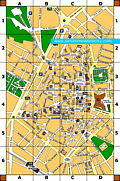
Tourist info offices
Address: Via V. Emanuele, 24
Phone number: +39 0832 682985
Address: Viale XXV Luglio - Castello Carlo V
Phone number: +39 0832 246517
Address: Piazza Sant'Oronzo - Il Sedile
Phone number: +39 0832 242099
Distance from Ostuni: 76 km
Time to get there by car: about 52 minutes
eBook guide of Lecce
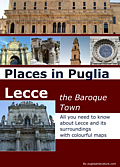
Places in Puglia: Lecce the Baroque town
What's inside: history of Lecce and its monuments. The surrounding area: protected areas and archeological sites. La dolce vita in Lecce with the best restaurants, pubs, bars and night bars. Uselful info and praticalities. Plus 4 useful maps.
E-book for Kindle, Ipad, Iphone, Smartphone, Tablet, PC e Mac.
Get it from Amazon.co.uk
Get it from Amazon.com
What to see in Lecce
The heart of Lecce is Piazza Duomo, a piazza with a single entrance, of an enchanting beauty.
Duomo
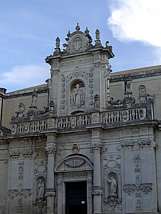
The Duomo of Lecce has two main façades. The left hand side of the Duomo, the one that faces the entrance of the piazza, presents a richly decorated 17th century portal crowned by a statue of Saint Oronzo with at tow sides the the statues of Saint Giusto and Saint Fortunato. The main façade is more sober and is decorated with flutes pilasters and niches containing the statues
Inside, a superb marble and gilded bronze high altar is devoted to the Assumption of the Virgin Mary, depicted in a large central painting by Antonio Tiso.
Campanile
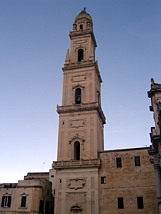
The Campanile is a 72 meter high bell tower of a square shape, built between 1661 and 1682 by local architect Giuseppe Zimbalo. It consists of five levels, each one smaller than the previous one. The upper floors have lancet windows and balconies with balustrades, running around all four walls.
Palazzo Arcivescovile
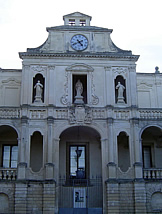
The Palazzo Arcivescovile is home to the state apartments, the bishop's residence and the offices of the Diocesan curia. Inside the palace a gallery displays a statue of the Assumption and paintings by Catalano and Giordano.
This palace was commissioned by Girolamo Guidano, Bishop of Lecce between 1420 and 1425. It was enlarged in 1649 by Bishop Pappacoda, who had the right wing guest rooms built.
Palazzo del Seminario
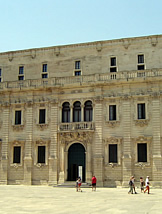
The Palazzo del Seminario is one of the most important Baroque monuments of Puglia. Its façade is divided into two sections, the lower half consisting of two floors with sixteen richly decorated windows, and a simpler more linear upper third floor, designed by Manieri. The central portal is surmounted by a balcony with a three-arched window.
Piazza Sant'Oronzo
Another important piazza of Lecce with several interesting monuments is Piazza Sant'oronzo.
Roman Amphitheatre
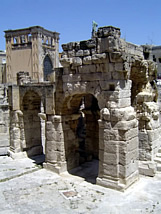
The Roman Amphitheatre was excavated between 1904 and 1940. Oval-shaped, it measures 102 metres long and 82 metres wide, with an arena of 53 by 34 metres, and could accommodate some 25.000 spectators. Only a part of it can be seen today; the rest still lies buried beneath important secular buildings situated around the piazza.
Obelisk of Saint Oronzo
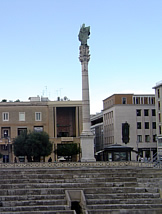
The pillar of this obelisk, with at its top the Venetian bronze statue of Saint Oronzo, was originally part of a set of two pillars marking the end of the Appian Way in the city of Brindisi. It was donated by the mayor of Brindisi to the city of Lecce, repaired and re-erected under the supervision of local architect Giuseppe Zimbalo.
Palazzo del Sedile
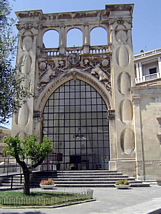
The majestic Palazzo del Sedile was commissioned in the 16th century by mayor Pietro Mocenigo. The large space inside is decorated with frescoes depicting the life of Charles V. There is also a Spanish inscription from King Charles III of Spain, thanking the city of Lecce for the two pitchers of the holy oil of Saint Oronzo he had received.
At few metres from Piazza Sant'Oronzo you can see the Chiesa di Santa Croce, the Convento dei Celestini and the Castle of Carlo V.
Basilica of Santa Croce

The Basilica of Santa Croce is considered the best example of the 'Barocco leccese'.
The lower half of the façade is divided into five sections by six columns, which support a richly decorated entablature. The coats of arms of Philip III of Spain, Mary of Eghien and Walter VI of Brienne are displayed above the central portal. The entablature is surmounted by a series of atlantes, lions and mythological creatures, which support a balustrade decorated with cherubs.
The upper half is dominated by the giant rose window adorned with floral motifs, and a niche on each side containing the statues of Saint Benedict and Pope Celestine V. At the far ends, there are female figures representing faith and charity.
Inside, the central nave has a superb gilded walnut coffered ceiling, whereas the aisles have cross vaults. The crossing is surmounted by a windowed dome, decorated with cherubs and floral motifs.
Convento dei Celestini
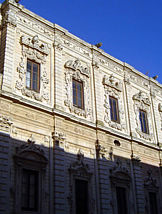
The beautiful building of Convento dei Celestini, just next to the church of Santa Croce, houses the offices of the Prefecture and the Province of Lecce.
Its construction started in 1549 by Riccardi, who designed the cloister and the lower section of the adjacent Basilica di Santa Croce. A century later, the building was completed by Zimbalo and Cino, who designed, receptively, the first and second levels of the façade.
Castle Carlo V
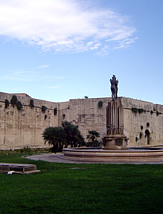
This castle was built during the reign of Charles V on the site of an previous fortress. Construction began in 1539, but it took ten years to finish the walls and the ramparts, while the interiors were completed at a later date.
Some parts of the Castle, such as the square tower in the centre date back to the 13th century, specifically the era of King Tancredi. The building forms a quadrangle with one bastion on each corner.
Lecce city gates
Porta Napoli
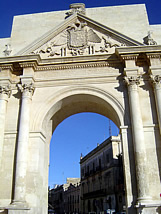
Porta Napoli is a triumphal arch-like structure built in honour of Charles V, who was responsible for the construction of the defensive fortifications of the city. As its name indicates, it originally marked the start of the road to Naples.
Porta San Biagio
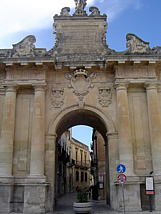
Porta San Biagio is one of the three entrances to the old quarter of Lecce and is situated on the southern side. It was built in 1774 to replace an older gate, dating back to Charles V.
The gate has double columns on either side. The coat of arms of the Bourbon king Ferdinand IV as well as those of the city are displayed above the arch. A statue representing Saint Biagio in bishop's robes stands at the top.
Porta Rudiae
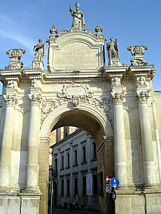
Porta Rudiae is the oldest and most interesting of the city gates. In ancient times, a road lead to the long vanished city of Rudiae.
The gate was rebuilt in 1703, the original having collapsed at the end of the 17th century. It consists of a single arch with two sets of columns on either side.
There are many others interesting buldings and churches to visit in Lecce, among them:
- Chiesa Madre di Dio e di San Nicolò
- Chiesa di San Matteo
- Chiesa di San Giuseppe
- Chiesa di Santa Irene
- Chiesa di S.G. Battista
- Palazzo Marrese
- Palazzo Palmieri
- Teatro Romano
Full list of museums in Lecce.
Ostuni
- Origins of Ostuni
- What to see in Ostuni
- Events in Ostuni
- Practicalities
- Seaside of Ostuni
- Masserie of Ostuni
- Trulli
- Museum of Ostuni
- Parks and protected areas
- Cuisine
- Images of Ostuni
- Ostuni local info
- Getting to Ostuni
Rentals
Services
- Property and land management
- Guest management
- Property restoration and reparing works
- Taxi service and taxi sharing service
- Services for disabled
Excursions
Food & Wine







